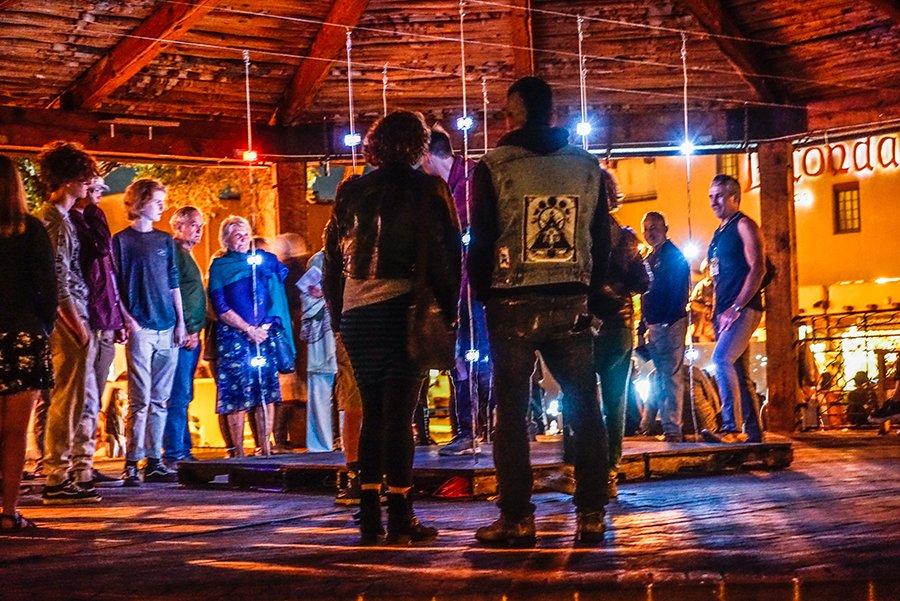Lothario Areski
Xalapa, Veracruz, Mexico
“hors-affichage” | Interacti Installation
hors-affichage. Is a game installation that explores the tensions between the visible and invisible, the reachable and unreachable always already suspending the player outside it’s display.
The installation consists of strips of luminescent metal cubes, deployed around a wooden platform, forming a sort of cage or veil players can interact with by touch.
When players touch a cube the game begins, causing cubes to start blinking. Players must rapidly touch the blinking cubes to make them stop, if the cubes blink for too long they turn red and if too many of them change color players lose the game.
The simplicity of the game mechanics make it a proper installation for any sort of context, and for every type of public. This dynamic also makes the game autonomous, a simple trial and error or observation is enough to understand how to play.
hors-affichage. is inspired by deconstruction and the french philosopher Jacques Derrida. It redefines the relationship between the display and the player by opposing them and leaving the player always already outside the display, either by not being physically at the center of it or by being inside it but unable to see it in its entirety.
“hors-affichage.”, in lower cases and with a point, references Derrida’s famous uttering “Il n’y a pas de hors-texte / hors-affichage.” translated as “There is nothing outside the text.” Which described by the London Review of Books means the following “A hors-texte is an unnumbered page in a printed book. Derrida is saying that even the unnumbered pages count, just as an outlaw, in French an hors-la-loi, has everything to do with the law, since it makes him what he is.”
In the same way, everything outside of the display has to do with the display creating an experience that is akin to a chase. Indeed, when someone is playing and there are no blinking cubes in their field of view they get into this state of chase, where they frantically turn around looking at the cubes in order to find the elusive blink. In other words, the most critical moment of the game is not when the players see the blinking cube and are able to touch them, but when the blinking cubes are hors-affichage.
Deconstruction is half a philosophy half a literary criticism process. By its very nature any attempts to define it simply would butcher it, with this in mind this is my understanding of it: Deconstruction seeks to confront binary oppositions, revealing the hierarchical superiority between two concepts; or in other words centring one of them while marginalizing
another one. Then, it inverts this hierarchy, the center concept becomes marginalized and vice versa. However, the objective of Deconstruction is not simply to invert a hierarchical relationship, as this would only be a meaningless substitution. Instead, it challenges the very concept of hierarchy and suspends concepts in a “free play of differences”, allowing concepts to have a non stable meaning.
What I seek to do with hors-affichage is to put players in this in-between state, where they are always preventing and allowing the free play of differences, the blinking, by impeding it in one cube and as a result producing it in another. A good player is a player that manages to keep the free play of differences going for as long as possible.
As a whole, hors-affichage. Seeks to contribute to a current of game installations that build bridges between games and art in order to expand the their understanding and reach a new kind of public.
About the artist: My name is Lothario, I was born in Mexico of a Mexican father and a French mother, as such I have always lived in between two worlds.
I lived in Mexico until I was 18 years old, then I moved to France to start my studies in game design, I would finish them in Denmark where I lived for one year.
I am currently based in Mexico developing installations and working as a cultural attache of the French Alliance of Xalapa.
During my studies I was greatly influenced by collectives such as One Life Remains and Mech Bird that used the medium of video games to create interactive digital art installations.
Following their path I started creating game installations, both collectively and on my one.
My installations range from computer and smartphone games to games with umbrellas and more elaborated installations using microcontrollers and home made electronics.
My main medium today is arduino, because it mingles perfectly both the digital world and the physical one allowing me to experiment with both.
Currently I am very interested in extracting my installations from screens and making the displays and feedbacks spatial and physical while maintaining the installations identity as digital games.
STEMarts LAB workshop leader at Taos High School



